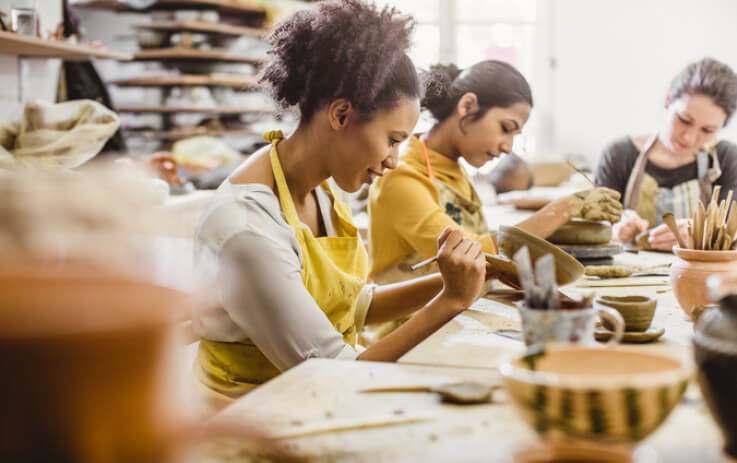B
Banding Wheel
Small turntable used for glazing or decorating ware.
Bat & Bat Board
A board used for clay, usually on the wheel.
Bisqueware
Clay ware which has been fired once, but not yet glazed.
Bone Dry Clay
Unfired clay which has lost all its moisture.
C
Calipers
Tool for measuring interior or exterior width, often used for making lids.
Centering - Coning up
When wheel throwing, one of two motions to bring the clay to center before...
Checking Depth
When wheel throwing, using a needle tool to find out how thick the clay is...
Cobalt Carbonate and Cobalt Oxide
Coloring oxide used for blues and blacks.
Collaring
When wheel throwing, bringing the clay in to make the pot narrower.
Colorant
Any element used to add color to glazes or clays.
Compressing the foot
When wheel throwing, pressing down on the base of the pot to make the clay...
Compressing the rim
When wheel throwing, finishing the rim with a rib, chamois, or fingers.
Cone Charts
ceramic materials which measure heat work in the kiln.
Copper Carbonate and Copper Oxide
Coloring oxides used for greens and metallic colors. IN reduction, can give...
Craze, Crackle, Crawl
Glaze surfaces may have surface variations which might be seen as a flaw or...
Cutting Off
When wheel throwing, removing the finished pot using a wire.
F
Faceting
Cutting flat faces into wet clay.
Fettling Knife
Long knife used for cutting clay.
Fluting
Cutting lines into a clay form with a loop tool or wire.
Flux
Fluxes are glaze materials which are added to lower the melting point of pa...
G
Glaze
A glassy coating of ceramic ware, made up of a combination of glass-formers...
Glaze Breaking
Glaze variation across the surface texture of a pot.
H
Handbuilding Methods
This video is a brief overview of techniques used to shape clay with ones h...
K
Kiln Posts
Kiln furniture
Kiln Wash
Refractory ceramic materials which are applied to one side of the kiln shel...
L
Leather Hard Clay
Unfired clay which is no longer soft and malleable, but can be easily cut w...
Lustres
Lustres are a special type of surface design material used in ceramics to a...
M
Manganese Dioxide
Coloring oxide used for purples, golds, and browns.
Matte, Satin, and Gloss
Glazed surfaces can be described as matte, satin, or gloss. Matte surfaces...
Melting Point
The temperature at which glaze material becomes liquid and fluid in the kil...
Mishima (Inlay)
Mishima is a technique of inlaying slip, underglaze, or even clay into a ce...
O
Opening
When Throwing on the Wheel, making a hole in the center of the clay to begi...
Oxidation and Reduction
Kiln atmosphere, either with a sufficient amount of oxygen for fuel combust...
P
Paddling
Lightly beating clay to flatten or shape it.
Paper Resist
Decorating technique where paper is used as a resist for colored slip or un...
Parts of a pot
parts of a pot
Peep Plug
Ceramic plugs used in the witness holes of the kiln.
Porosity
The ability of clay to absorb moisture or water.
Pulling the Walls
When Wheel Throwing, bringing the sides of the pot up with your hands.
Pyrometric Cones
Ceramic materials formulated to measure heat work in the kiln.
R
Red Iron Oxide
Coloring Oxide used for a variety of colors. By itself it gives a strong da...
Refractory
Ceramic materials which have very high melting points and are resistant to...
Rib
Wide tool used for smoothing, texturing, or shaping clay.
Ribbing the outside
When throwing on a wheel, using a rib tool on the outside of a pot to refin...
Rutile
Rutile is an oxide used for coloring glazes and for washes. As a wash it gi...
S
Scoring
Roughing up the surface of the wet clay to prepare it for joining.
Sgraffito
Decorating technique where a layer of colored slip or underglaze is carved...
Shivering
A glaze defect which occurs when the glaze shrinks more than the ware. It c...
Shrinkage
Calculating the shrinkage of clay as it dries and is fired.
Silica
The most commonly used and necessary glass-former used in glaze manufacture...
Slip, Engobe, Underglaze
Liquid clay, usually with colors added, with varying shrinkage rates, used...
Slip Trailers
Squeeze bottles used for applying slip or underglaze.
Slip Trailing
Slip Trailing is a decoration technique where underglaze or colored slip is...
Sprigging
Decorative technique, attaching a small, shallow, and usually molded piece...
W
Water Etching
A raw clay texture technique where wax, acrylic medium, or lacquer is appli...
Wax resist
Using wax to keep glaze or other ceramic materials from sticking to particu...
Wedging
Wedging is the process used in ceramics to work air bubbles out of clay so...
We're here to help
Please give us a shout if you have any questions, feedback, or comments.


